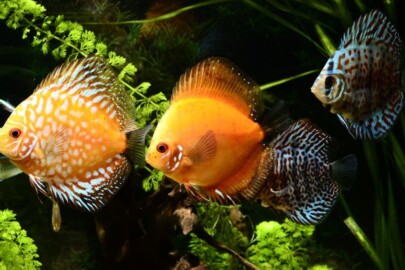Seahorse Tanks
Introduction
There are approximately 36 species of seahorses all belonging to the Sygnathid family (Genus Hippocampus). Pipe fishes and seadragons are also included in the Sygnathid family.
Characteristics
1. Unlike most fishes seahorses swim upright using only their dorsal and opercular (modified pectoral) fins for propulsion.
2. They do not have a caudal fin, in its place they have a long muscular prehensile tail.
3. They also lack any scales; instead their bone structure is modified into a series of plates that act as bony armor.
4. They have a horse-like head (giving it the name seahorse) with a bent neck and a long snout. This adaptation allows the seahorse to probe into nooks and crannies for prey, that they then suck up with a “snick” of the snout that causes a vacuum like suction.
Seahorse Fish tank
Although seahorses live in a diverse array of habitats, in a domestic setup they need the same basic care and water quality as other fishes. The main difference however with seahorses is their sensitivity to changes in water quality, temperature and light.
Factors to consider when setting up seahorse tanks include:
1. The filter. There should be no air bubbles and a low flow rate (this does not necessarily mean low gph). Seahorses like a fairly turbulence free tank, and air bubbles can lead to the dreaded Gas Bubble Disease (to be discussed later in the article).
2. The next most important thing is to get a tank that is tall, seahorses are known for their intricate courtship rituals that take up a lot of vertical space. Substrate can vary by what decor you are looking for. Just remember that whatever substrate you chose, it should not have too many sharp edges for the seahorse to get cuts from. I prefer to use a small crushed coral or sand substrate.
3. The hitching posts; rocks, plants, and corals (faux and real) should be chosen by their ability to be used as a hitching spot. Depending on species of seahorse, the size and maximum diameter of the hitching posts will vary.
Seahorse Tanks – Feeding and Diet
Seahorses should be fed on frozen, enriched foods. Live foods should therefore, only be used as an enrichment item. Frozen food should always be enriched with a vitamin supplement as well as something such as selcon that is high in fatty acids.
Seahorse Tanks – Diseases
1. Mycobacterium. This is very common and is fatal. Symptoms inclide: lethargy, loss of appetite, an abdomen that is very pinched or swollen, and eventually muted color/loss of vibrance. Treatment include Kanamyacin and Maracyn which should be administered orally.
2. Vibrio. This is difficult to detect early and is fatal. Symptoms include; lethargy, loss of appetite, and white or red spots on the skin indicating an open necrotic wound. Often when tail rot or snout rot is seen it is vibrio. Treatment is a multiple antibiotic especially when detected early.
3. Gas Bubble Disease (GBD). There are three main types of GBD, internal GBD (IGBD), external GBD (EGBD) and pouch emphysema. All GBD is caused either by gas supersaturation in the water column, or an internal bacterial infection. EGBD symptoms include gas bubbles forming under the skin. While IGBD symptoms include body bloat causing buoyancy problems. Pouch emphysema is only found in male seahorses, and is noticeable by the inflamed, reddened pouch (looks different from a pregnant seahorse). Treatment typically consists of 3 things: making sure there are no air bubbles getting into the system, treating with an antibiotic, and if available (only by prescription) treating with diamox. The actual bubbles under the skin may be popped, and with pouch emphysema the pouch should be evacuated.






